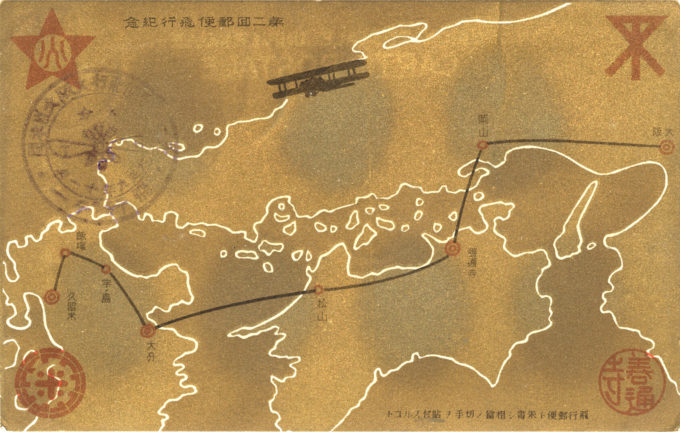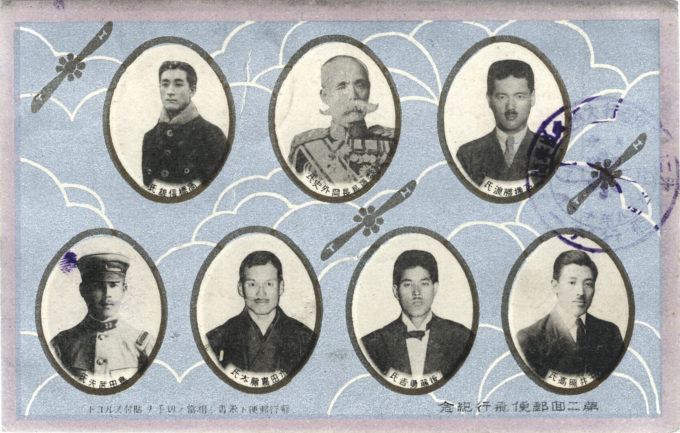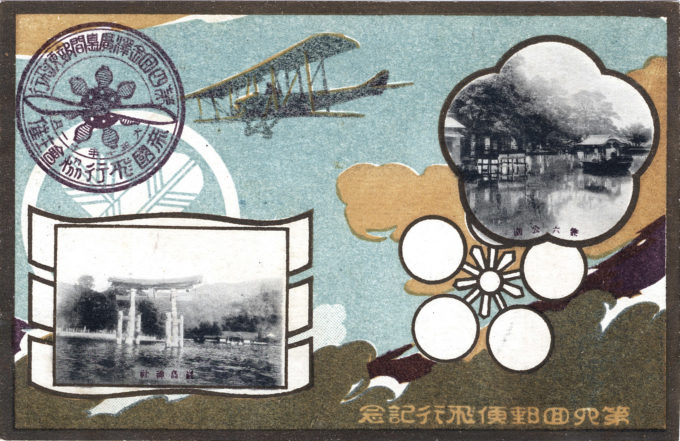
The 2nd air mail flying contest map depicting the route from Osaka (right) to Kurume, via Okayama, Zentsuji, Matsuyama, Oita, Unoshima, and Izuka, November 1920.
See also:
Tokyo-Osaka-Tokyo Air Race, 1920.
Asahi Shimbun (Newspaper) Building, Sukiyabashi, Tokyo, c. 1930.
“In Japan, various historical and political factors favoured the rapid start-up of air transport. The popularity of kites in all forms and colours; the interest shown by Emperor Meiji in military balloons from 1877 onwards; the participation of the first unit of Japanese balloonists in the capture of Port Arthur in 1904 during the Russo-Japanese War; the appearance of an aircraft building activity carried out by artisans and very much inspired by French models …
“To these should be added the very considerable influence of the Imperial Aeronautical Association, founded in 1913 under the presidency of Count General Nagaoka Gaishi, which was at the forefront in the birth and development of Japanese aviation. Between 1919 and 1922 it was responsible for organising airmail flying contests, during which the participants had to complete a course in the best time.
2nd Air mail flying contest, Osaka-Kurume, November 1920. The winning pilot, Ishibashi Nobuo, is pictured at top-left; the president of the Imperial Aeronautical Association, Count Nagaoka Gaishi, is pictured top-row-center.
“These unusual competitions were endowed with prizes, and had more in common with exhibition flights and sporting trials than with air transport, but their aims were clear: to establish airmail links inside Japan. [Among] the principal competitions were:
22nd October 1919: The first airmail flying contest took place from Tokyo to Osaka and return, in which Japanese-manufactured Itoh and Nakajima aeroplanes took part;
20th November 1920: The second airmail flying contest from Osaka to Zentsuji, Oita and Kurume (on the island of Kyushu) was won by pilot Ishibashi Nobuo in a French-made Spad 13;
21st August 1921: The third airmail flying contest took place over a course from Tokyo to Morioka (340 miles to the north) and return. No participants finished the course due to fog;
21st November 1921: The fourth airmail flying contest was held from Kanazawa, on the Japan Sea, to Hiroshima in the south of island of Honshu;
November 1922: The fifth airmail flying contest was organized on a larger scale over the original Tokyo/Osaka/Tokyo course. It brought togther 14 civilian pilots and continued for a whole week, giving a measure of the progress accomplished since 1919. The record time had been reduced from 6 hours 58 minutes to 4 hours 49 minutes.”
– History of Air Cargo and Airmail from the 18th Century, by Camille Allaz, 2005



